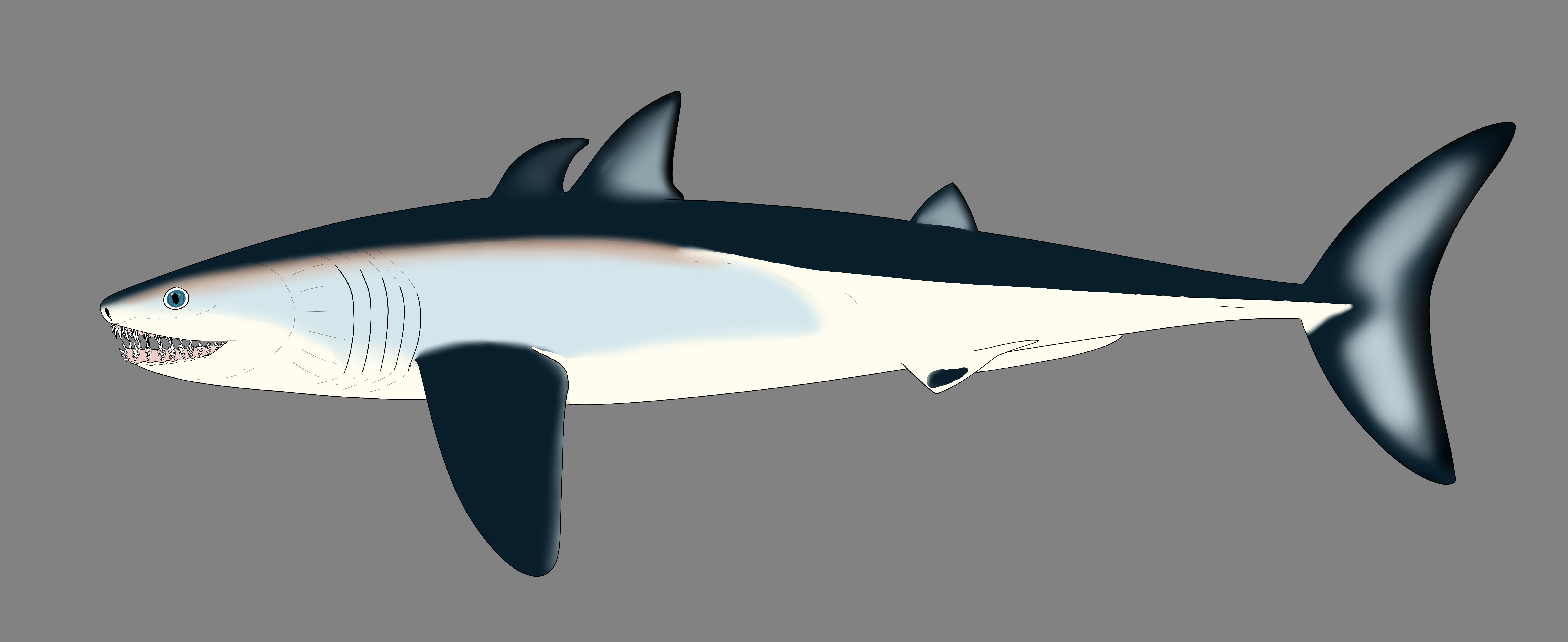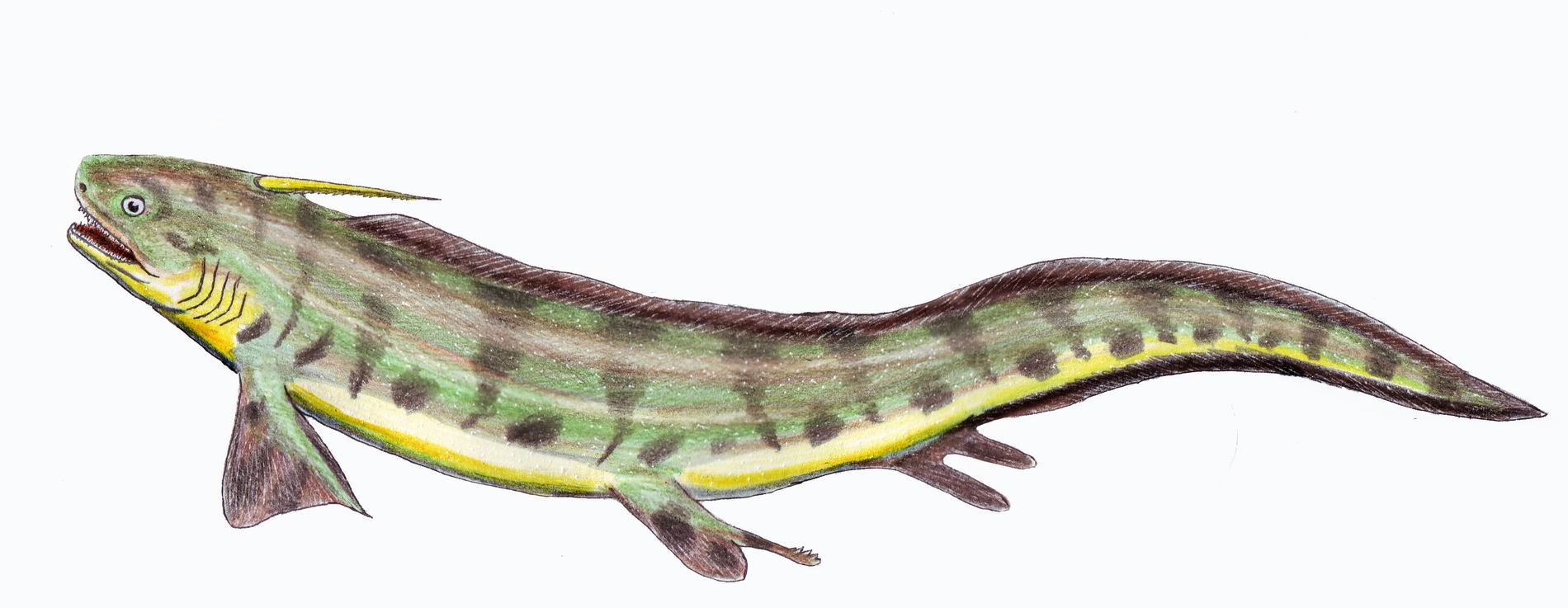|
Dracopristis
''Dracopristis'' is an extinct genus of ctenacanth (a group of shark-like elasmobranchs) that lived around 307 million years ago, during the Pennsylvanian sub-period of the Carboniferous period. The fish had 12 rows of short, squat teeth, and an array of spines on its dorsal fins. The main differentiation between ctenacanthiformes and true sharks is that ctenacanthiform mouths are larger but less flexible than the true sharks. The spines of the holotype fossil are about 0.57 meters long, and the whole body was around 2 meters (6 ft) long. Discovery and description Fossils of ''D. hoffmanorum'' were first discovered in 2013, when a graduate student unearthed the fish's remains from late Pennsylvanian age rocks of Albuquerque, New Mexico. The creature was formally named seven years later in a 2021 paper which described, named and classified it. The fish's fossils were found within the Tinajas member, which dates to the late Pennsylvanian. The holotype specimen, named ... [...More Info...] [...Related Items...] OR: [Wikipedia] [Google] [Baidu] |
Squatinactis
''Squatinactis'' is a genus of extinct Elasmobranchii, elasmobranch Chondrichthyes known from the Carboniferous aged Bear Gulch Limestone, Bear gulch limestone in Montana. This fish was discovered in 1974 by Richard Lund. The Holotype, type specimen, named CMNH 46133, consists of a Neurocranium, brain case, poorly preserved Mouth, jaws and gills, a pectoral fin, and a partial Vertebra, vertebral axis. This creatures most startling feature were its broad pectoral fins which resembled those of Stingrays and Angel sharks (Angelshark, ''Squatina''). The holotype specimen has about 15 Tooth, teeth in its jaw. This creature is named after the angel shark. Teeth found in Derbyshire, England have been tentatively identified as those belonging to ''S. caudispinatus.'' Description ''Squatinactis'' had a flattened body with a set of large pectoral fins. This fish was vaguely similar to today's Stingray, stingrays and angel sharks. The flins were oddly pointed forward, with a length of arou ... [...More Info...] [...Related Items...] OR: [Wikipedia] [Google] [Baidu] |
Cladoselache
''Cladoselache'' is an extinct genus of shark-like chondrichthyan (cartilaginous fish) from the Late Devonian (Famennian) of North America. It was similar in body shape to modern lamnid sharks (such as mako sharks and the great white shark), but was not closely related to lamnids or to any other modern (selachian) shark. As an early chondrichthyan, it had yet to evolve traits of modern sharks such as accelerated tooth replacement, a loose jaw suspension, enameloid teeth, and possibly claspers. Some 20th century studies considered ''Cladoselache'' to be a basal (early-diverging) member of Elasmbobranchii, the fork of cartilaginous fish which leads to modern sharks and rays. More recent studies have identified distinctive traits of the chondrocranium (cartilaginous braincase), dorsal fin spines, and pectoral fin bases. These newly identified features support a close relationship to symmoriiforms, a small group of bizarre chondrichthyans such as the bristle-spined '' Stethacanthu ... [...More Info...] [...Related Items...] OR: [Wikipedia] [Google] [Baidu] |
Carboniferous
The Carboniferous ( ) is a geologic period and system of the Paleozoic that spans 60 million years from the end of the Devonian Period million years ago ( Mya), to the beginning of the Permian Period, million years ago. The name ''Carboniferous'' means "coal-bearing", from the Latin '' carbō'' ("coal") and '' ferō'' ("bear, carry"), and refers to the many coal beds formed globally during that time. The first of the modern 'system' names, it was coined by geologists William Conybeare and William Phillips in 1822, based on a study of the British rock succession. The Carboniferous is often treated in North America as two geological periods, the earlier Mississippian and the later Pennsylvanian. Terrestrial animal life was well established by the Carboniferous Period. Tetrapods (four limbed vertebrates), which had originated from lobe-finned fish during the preceding Devonian, became pentadactylous in and diversified during the Carboniferous, including early amphibian line ... [...More Info...] [...Related Items...] OR: [Wikipedia] [Google] [Baidu] |
Genus
Genus ( plural genera ) is a taxonomic rank used in the biological classification of extant taxon, living and fossil organisms as well as Virus classification#ICTV classification, viruses. In the hierarchy of biological classification, genus comes above species and below family (taxonomy), family. In binomial nomenclature, the genus name forms the first part of the binomial species name for each species within the genus. :E.g. ''Panthera leo'' (lion) and ''Panthera onca'' (jaguar) are two species within the genus ''Panthera''. ''Panthera'' is a genus within the family Felidae. The composition of a genus is determined by taxonomy (biology), taxonomists. The standards for genus classification are not strictly codified, so different authorities often produce different classifications for genera. There are some general practices used, however, including the idea that a newly defined genus should fulfill these three criteria to be descriptively useful: # monophyly – all descendants ... [...More Info...] [...Related Items...] OR: [Wikipedia] [Google] [Baidu] |
Tinajas Member
The Atrasado Formation is a geologic formation in New Mexico. Its fossil assemblage dates the formation to the Kasimovian age of the Pennsylvanian. It was formerly known locally as the Wild Cow Formation or the Guadelupe Box Formation. Description The formation consists primarily of marine limestone with some sandstone and shale. It is exposed in the Sandia Mountains, the Lucero Uplift (), the western Jemez Mountains, and in the Manzano Mountains. The formation has been mapped as the Wild Cow Formation in the Manzano Mountains and as the Guadelupe Box Formation in the Jemez Mountains. However, Spencer G. Lucas and coinvestigators have recommended abandoning the name Wild Cow Formation and using Atrasado Formation throughout the Madera Group. The formation is likely correlative with the Alamitos Formation in the Sangre de Cristo Mountains. The formation is underlain by the Gray Mesa Formation, with its base defined by a sandstone interval atop an eroded limestone surface of th ... [...More Info...] [...Related Items...] OR: [Wikipedia] [Google] [Baidu] |
Triodus
''Triodus'' is an extinct genus of xenacanthidan shark that lived from the Carboniferous to the Triassic. It was a freshwater shark, and fossils have been found in the Chinle Formation and Black Prince Limestone of Arizona, the Petrified Forest Member of New Mexico and the Tecovas Formation of Texas, United States.''Triodus'' at .org In 2017, a new species ''Triodus richterae'' was described from the of Brazil
[...More Info...] [...Related Items...] OR: [Wikipedia] [Google] [Baidu] |
Thrinacoselache
''Thrinacodus'' is an extinct genus of basal elasmobranch, found worldwide from the Late Devonian-Lower Carboniferous. Most species are only known from their tricuspid teeth. ''T. gracia'', originally placed in the separate genus ''Thrinacoselache'' from the Serpukhovian-aged Bear Gulch Limestone, of what is now Montana, is known from full body impressions, showing a long, slender eel-like body up to a metre in length, with an elongate rostrum. Stomach contents of ''T. gracia'' include remains of crustaceans and small chondrichthyan fish ('' Harpagofututor'' and ''Falcatus''). It is a member of the Phoebodontiformes Phoebodontiformes is an extinct group of elasmobranchs, known from the Devonian and Carboniferous periods. It includes the genera ''Phoebodus'', '' Diademodus'' and '' Thrinacodus''. ''Phoebodus'' and ''Thrinacodus'' have slender, elongate bodies .... References Carboniferous sharks {{paleo-shark-stub Fossil taxa described in 1875 ... [...More Info...] [...Related Items...] OR: [Wikipedia] [Google] [Baidu] |
Holdenius
''Holdenius'' is an extinct genus of arthrodire placoderm fish which lived during the Late Devonian period. Description ''Holdenius'' was a large arthrodire, reaching lengths of around . This placoderm is known only from isolated jaw bones, and little is known about it except that it is relatively morphologically similar to its more famous relative ''Dunkleosteus'', with which it shared a spatial and temporal range. ''Holdenius'' was a piscivorous animal that used its sharp shearing gnathal plates to seize and cleave its prey into manageable pieces. One articulated specimen of this placoderm from the Upper Devonian Cleveland Shale was preserved adjacent to the remains of its prey; a ''Ctenacanth'' chondrichthyan, which had been bitten in half. Considering its prey was over half its size, it can be inferred that ''Holdenius'' was an exceptionally aggressive nektonic predator. An anterior dorsal spine from the ctenacanth was found lodged in the palate and extending into the bra ... [...More Info...] [...Related Items...] OR: [Wikipedia] [Google] [Baidu] |
Placodermi
Placodermi (from Greek πλάξ 'plate' and δέρμα 'skin', literally 'Plate (animal anatomy), plate-skinned') is a Class (biology), class of armoured prehistoric fish, known from fossils, which lived from the Silurian to the end of the Devonian period. Their head and thorax were covered by articulated armoured plates and the rest of the body was scale (zoology), scaled or naked, depending on the species. Placoderms were among the first jawed fish; their Fish jaw, jaws likely evolved from the first of their gill arches. Placoderms are thought to be paraphyly, paraphyletic, consisting of several distinct Outgroup (cladistics), outgroups or sister taxon, sister taxa to all living jawed vertebrates, which originated among their ranks. In contrast, one 2016 analysis concluded that placodermi are likely monophyletic, though these analyses have been further dismissed with more transitional taxa between placoderms and modern gnathosthomes, solidifying their paraphyletic status. Plac ... [...More Info...] [...Related Items...] OR: [Wikipedia] [Google] [Baidu] |
Orthacanthus
''Orthacanthus'' is an extinct genus of fresh-water xenacanthid sharks, named by Louis Agassiz in 1836, ranging from the Upper Carboniferous until the Lower Permian. ''Orthacanthus'' had a nektobenthic life habitat, with a carnivorous diet. Multiple sources have also discovered evidence of cannibalism in the diet of ''Orthacanthus'' and of "filial cannibalism" where adult ''Orthacanthus'' preyed upon juvenile ''Orthacanthus.'' The genus ''Orthacanthus'' has been synonymized with ''Dittodus'' (Owen, 1867), ''Didymodus'' (Cope, 1883), and ''Diplodus'' (Agassiz, 1843). About 260 million years ago, ''Orthacanthus'' was the apex predator of freshwater swamps and bayous in Europe and North America. Mature ''Orthacanthus'' reached nearly 3 meters (10 feet) in length. ''Orthacanthus'' teeth have a minimum of three cusps, two principal cusps, and an intermediate cusp, where the principal cusps are variously serrated, with complex base morphology. Additionally, ''Orthacanthus'' can be dia ... [...More Info...] [...Related Items...] OR: [Wikipedia] [Google] [Baidu] |
Adolescence
Adolescence () is a transitional stage of physical and psychological development that generally occurs during the period from puberty to adulthood (typically corresponding to the age of majority). Adolescence is usually associated with the teenage years, but its physical, psychological or cultural expressions may begin earlier and end later. Puberty now typically begins during preadolescence, particularly in females. Physical growth (particularly in males) and cognitive development can extend past the teens. Age provides only a rough marker of adolescence, and scholars have not agreed upon a precise definition. Some definitions start as early as 10 and end as late as 25 or 26. The World Health Organization definition officially designates an adolescent as someone between the ages of 10 and 19. Biological development Puberty in general Puberty is a period of several years in which rapid physical growth and psychological changes occur, culminating in sexual maturity. The aver ... [...More Info...] [...Related Items...] OR: [Wikipedia] [Google] [Baidu] |
.jpg)





